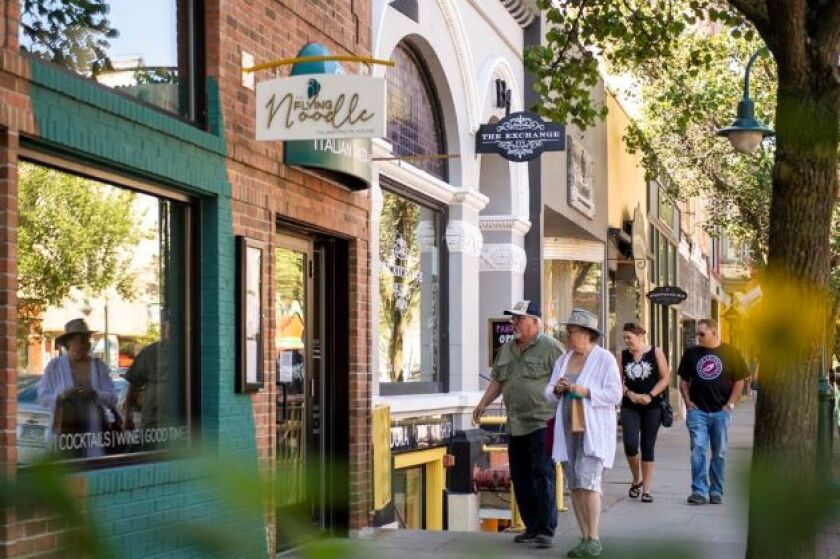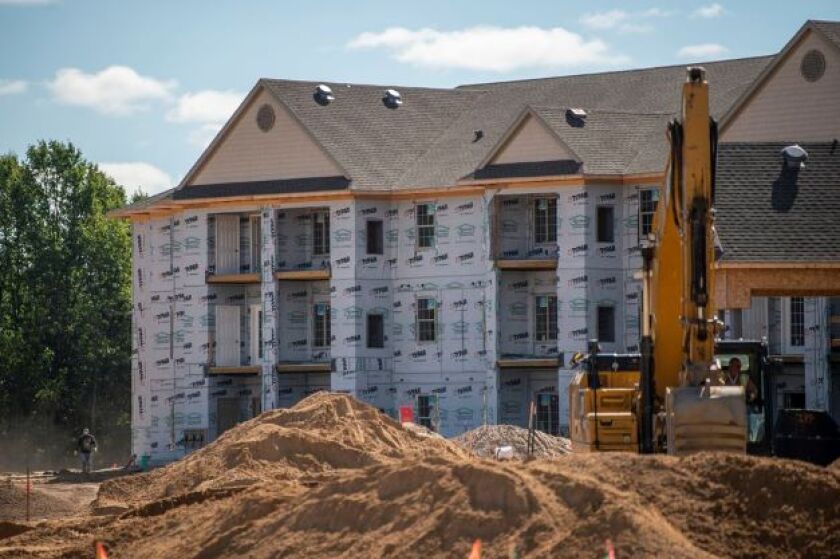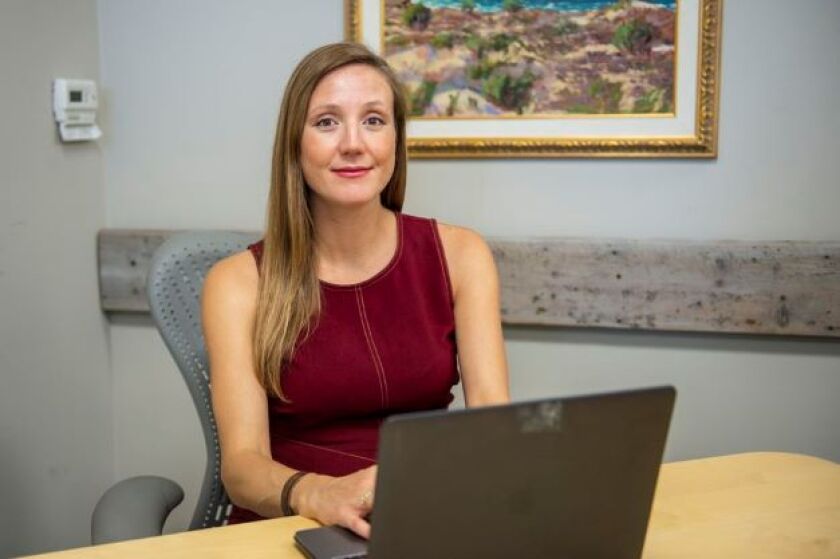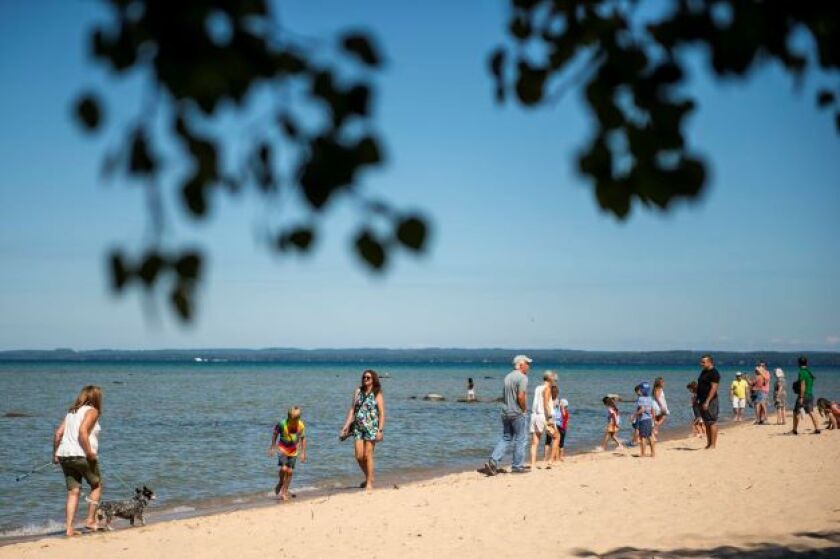They duct taped every opening or crevice – even the dryer vents in the basement – to isolate themselves from the smog looming outside.
Amiel Handelsman and his family were locked in their Portland home for a week as Oregon newspapers reported the air quality was literally off the charts – 516 of 500 on the index for hazardous conditions.
He reached out to friends and family in Ann Arbor, the hometown he left more than 20 years ago, and found a place to stay with his wife, Julie Endress, and two sons, now ages 10 and 13.
The next few weeks in Michigan, Handelsman, a 52-year-old leadership coach, and Endress, a 53-year-old meditation teacher, reflected on a pattern of smoke-riddled summers in Oregon. The fire they were escaping in September 2020 would go on record as one of the most destructive in the state’s history.
They headed west because they wanted something new, fresh, cutting-edge, Handelsman said. “Those words with smoke wrapped around them are less appealing.”
In summer of 2021, the family moved permanently to Ann Arbor, joining a growing movement of so-called climate migrants.
Michigan looks increasingly attractive in a country where wildfires turn million-dollar mansions to ash in California, intensifying hurricanes sink homes along Florida’s coasts, and cities like Las Vegas and Phoenix face the alarming reality the Colorado River will no longer sustain them.

Heat Hazards Expected to Creep North; What the U.S. Might Look Like in 2100
This state’s two peninsulas, meanwhile, have ample freshwater – the Great Lakes contain 90 percent of North America’s supply, lower temperatures, and vast swaths of undeveloped land.
MLive interviewed 16 academics and scientists – one himself a Michigan migrant, and all deem the state a climate haven, regions expected to avoid the worst outcomes of climate change and with capacity to develop infrastructure for growing populations.
Internationally renowned researcher and author Parag Khanna thinks the Great Lakes, and Michigan in particular, will be the best place to live by 2050.
The area, however, is not immune from the consequences of global warming, caused by human use of fossil fuels that drive the greenhouse effect. Heavier rainfall. Stronger snowstorms. Changes to plants and wildlife. And people – potentially millions more people.
“The whole world is going to want to come here or take our water. We cannot let that happen. But what we can do is have a strategic plan for population growth and management of our natural resources,” Gov. Gretchen Whitmer said in October.
Experts warn that unless Michigan starts planning for those migrants, the expected influx of people might bring a host of problems with them – sprawl catering to the affluent, spikes in housing prices and congested traffic.
The time is now because they already are coming. No longer tethered to their downtown offices, they are leaving Washington, Missouri, and the Southwest, and settling instead in Houghton, Traverse City, and tiny L’Anse, at the base of Lake Superior’s Keweenaw Bay.
Ready or not.

Shifting Climate, Moving People
More than 34 million people in the United States and Canada currently depend on the Great Lakes for drinking water, but experts predict that number may dramatically increase.
Jesse Keenan, an associate professor of sustainable real estate at Tulane University in New Orleans, created a list of the best climate havens across the United States, and most are in the Northeast and Upper Midwest. The list includes Ann Arbor and at least six Great Lakes shoreline cities: Buffalo, New York; Detroit; Duluth, Minnesota; Milwaukee; Rochester, New York; and, Toledo, Ohio.
He predicts as many as 50 million Americans may relocate to climate havens within the U.S. in the coming decades, likely sooner rather than later.
“Very few places really tick all those boxes the way the U.S.- Canada border region in general and the Great Lakes in particular do, given the freshwater supply and so forth,” said Khanna, a Singapore-based geopolitics and globalization expert.
By 2100, Michigan can expect to become home for – at minimum – tens of thousands fleeing rising ocean waters alone. A more extensive analysis, yet to be published, proves this a vast underestimate, said Matt Hauer, a sociology researcher and assistant professor at Florida State University who studies how expected sea level rise will shift populations. Those escaping drought, heat, and wildfire risk will more substantially affect the Great Lakes, he said.
"Most of Michigan could position themselves to be the right place, for the right people at the right time. But it’s all about positioning and being sure that when people will look at their selection of destinations, Michigan is one that looks very feasible for them."
Climate migration isn’t about outrunning climate change. Khanna says social and political factors need to align to create what he calls “climate oases,” the right combination of political stability, environmental security, industrial-economic potential, and more. The worldwide list isn’t long, and Michigan ranks at the top, he said.
Paradoxically, he notes, Michigan is depopulating.
Michigan recorded its largest population ever in U.S. Census data in 2020, yet growth lagged most of the nation and the state lost one seat in Congress.
That’s mostly attributable to economic forces that have nothing to do with climate. For instance, taxes are lower in Florida and Texas.
If there was a financial cost to climate risks, then these disaster-prone areas would become more expensive, Khanna said.
Climate haven city Duluth, Minnesota, similarly experienced sluggish population growth in the 2020 census, despite being a vibrant city increasingly known as "climate proof." Experts there suggested the paradox was attributable to a lack of new housing growth, particularly affordable housing.
Data scientist Derek Van Berkel, assistant professor at the University of Michigan, said recent census data won’t necessarily reflect any hints of future migration. Those arriving for climate don’t yet outnumber those leaving for other reasons, like better-paying jobs.
Researchers hypothesize those already moving to Michigan are forward-thinking and climate-conscious, with enough money to relocate, Van Berkel said.
Big unknowns are whether and when climate circumstances will necessitate more widespread migration.
"If we look at communities throughout the U.S., there is this thought that it’s not only going to be these rich, affluent white folks. But it might be other folks, as well," Van Berkel said.
Climate change-fueled extreme weather events displaced about 30 million people around the world in 2020, and conditions are expected only to worsen.
In the United States, about 40 percent of the population lives in coastal areas, where projections say rising sea levels could displace upward of 13 million Americans by 2100. The Southwest just weathered the driest 22-year period in 1,200 years, and since 2000, thousands of wildfires burned double the acreage they did in the 1990s.
By 2100, Houston is projected to have summers more like Pakistan, while Phoenix will be comparable to the hottest season in Saudi Arabia, data scientists recently found in an analysis of 247 U.S. cities.
Traverse City, Alpena, and Marquette, in contrast, will respectively compare to summers in Indiana and Illinois. Saginaw, Lansing, and Grand Rapids will feel like Memphis, Tennessee.
If milder temperatures and water were beacons, they’d lead clearly to a region centered by Michigan, gleaming and blue.

Desirable Locale
Karen Blanco, 42, and her husband, Logan Halley-Winsett, 35, were looking for a place minimally impacted by climate change.
Blanco drew a six-mile radius around the U.P., looking to touch water, and chose L’Anse. They moved into a two-bedroom fixer-upper in April.
After living in Asheville, North Carolina, Milwaukee, Wisconsin, and St. Louis, Missouri in the last decade, Blanco and Halley-Winsett witnessed housing prices soar and supply buckle under high demand.
“Hopefully, we’re all learning from those experiences [of] seeing the places that we love kind of turn a corner,” Blanco said. “A lot of us who are moving here don’t want that experience [and] are going to ensure that we really respect what’s going on here locally.”
She took a job as the Baraga County Chamber of Commerce associate executive director. Her husband, a project manager for a Japanese company, can work anywhere.
It’s been an adjustment to lack some accommodations, but it’s a welcome change, Blanco said. She jokes she now considers the chimney repairman a king.
Michigan’s U.P. has long been treasured as a place of pristine, natural beauty with an abundance of wide-open spaces, ideal for both diverse wildlife and outdoor recreation.
While most of the rural U.P. lost population in the last census, Pickford Township between Sault Ste. Marie and St. Ignace in the eastern U.P. and spots in the Keweenaw Peninsula near Copper Harbor and Houghton saw growth.
Victoria Williams, 53, owns a long-running diner in downtown Houghton. She can often be found there cooking breakfast on the grill or mixing dough for big loaves of fresh sourdough bread she sells for just a few dollars.
Williams, born in Ypsilanti, has lived in the Houghton area since she was 7.
She said newcomers stand out amid the locals. Some like the community the way it is but others seem to want to make changes, particularly those accustomed to big-city amenities.
"We don’t want this turned into that. That’s why we don’t live in the bigger cities. We like it the way it is. We like the slow pace," Williams said.
Overall, she said the community is welcoming, and it helps when the new folks are nice to the locals.
"The ones that want to keep it the way it is are very interesting. I mean, I like people. Don’t get me wrong. I do and I like them from all walks. But some also come in with this attitude that, ‘I’m better than you because you’re a hick because you live here.’"
Coming to Michigan’s far north, Blanco said she knew they needed to know their neighbors "because our survival depends on it."
“I’ve kind of put us in a place where community is so important. I think I really craved that, where you really can use your skills and talents to help someone else and they do the same for you and fill in the gaps for everybody.”

Planning a Refuge
Head several hours south of the U.P. and it’s easy to see some of the effects of rapid population growth.
The work-from-home economy amplified an interest in Traverse City that began decades earlier. Up-north vacation homes became year-round residences. Housing prices hit the roof in the longtime tourist town and demand for new homes skyrocketed.
That erratic real estate market led to bidding wars over even modest homes, a trend that boxed out local workers and led some businesses to acquire their own housing for employees.
“The fact that we are home to 20 percent of the world’s freshwater makes us highly desirable from a longevity standpoint,” said Ashley Soltysiak, climate and environment program director for the Traverse City-based nonprofit Groundwork Center for Resilient Communities.
A key part of community planning is to ensure enough housing for people across the socio-economic spectrum, not just the affluent with resources to win real estate wars. This requires denser housing development connected to public transit. More bike routes. More sidewalks and pathways.
If done properly, it could culminate with economic payoffs – even a major windfall.
“This means more job creation, more folks working from the state. That does translate to real dollars that can be spent on those infrastructure challenges. It’s certainly not a totally negative picture. But it’s one that we just don’t want to get behind the ball on planning,” Soltysiak said.
Some are taking bold action. Voters in Ann Arbor approved in November a 1-mill tax for community climate action through 2043. It would, among other measures, fund city investments in renewable energy, electric vehicle chargers, rain gardens and cycling infrastructures.
“It’s real convenient not to talk about this. And when you talk about this, it’s not just talking about climate migration,” said Missy Stults, manager of Ann Arbor’s sustainability office. “You also have to talk about land use today...”
Ann Arbor recently commissioned a study to explore the effects of climate migration pressure. It found the local water and sewer systems will experience major impacts.
The city is looking for physical solutions from the ground up – literally – whether that be pavement that can reduce stormwater runoff or residential construction placed closer to transportation options to reduce driving.
Stults argues rather than approaching the climate haven challenge community-by-community, there needs to be a statewide conversation about climate migration.
Michigan has an emissions reduction plan, but there is no broader statewide resiliency plan or climate migration handbook.
“But we recognize science, we understand the impacts of climate change, and we need to make sure that as a state we’re preparing our residents – current and future – for that reality,” said Cory Connolly, climate and energy advisor who leads Michigan’s Office of Climate and Energy.
Much of the best resilience and sustainability planning happens at the local level, he said, and now is the time to leverage federal infrastructure dollars to achieve those goals.
People already here understand the draw, and they have some concerns.
Ben Nimphie, 35, never thought about Michigan as a climate haven, but he was surprised to see how his hometown Grand Rapids took off in the few years he spent in Boston. The city is much more developed than when he was a kid in the 1990s – from 1990 to 2020, Kent County has grown by more than 157,000 people, according to Census data.
Nimphie, a writer, has moved back and started a family.
He said he welcomed anyone escaping wildfires and looking for refuge along the lakeshore. It just depends where in West Michigan they land.
"I live in East Grand Rapids and there’s no room for new neighbors. You can’t build anymore houses here unless you tear some down," said
“But I think Grand Rapids has a lot of capacity for more people. Kent County and Ottawa County, we can handle more. I think that’s a good thing.”

Rust Belt Goes Green
Climate haven may be Michigan’s next branding strategy.
"We have to figure out how to begin to state in a thoughtful, compassionate way, our competitive advantage that we are going to be a relative climate winner," said Quentin Messer Jr., CEO of the Michigan Economic Development Corporation.
Climate scientist Jonathan Overpeck, a University of Michigan professor who fled the Southwest, said the state should capitalize on its manufacturing history amid a transition from fossil fuels to clean technology.
"We can be supplying the whole world and that’ll be a big, new boon just like the early 20th century. We will revitalize that renaissance, to use the word from Detroit," Overpeck said.
More people mean more jobs and resources. It can also mean more competition.
Experts fear the wealthy will move into climate havens while others will be left in climate danger zones. Meanwhile desirable areas may become gentrified, pushing out lower-income locals.
Michigan’s affordable climate haven may be the best kept secret. But not for long.
"I think people are going to be looking for a certain level of lifestyle that you can get here that you can no longer get on the West Coast, especially if you don’t have gobs of family money behind you," said Nadine Basile, 48.
For her, the "heat dome" was the last straw. In June 2021 the Pacific Northwest had a heat wave so extreme scientists said it was a 1-in-10,000-year event.
Basile found herself questioning why she was tending grape crops at risk of being tainted by wildfire smoke every year. The deadly heat also put her on edge about caring for livestock.
“Those kinds of conditions just got to be grueling,” she said. That winter Basile and her husband Jon, started looking for property closer to his parents in Leelanau County.
In the year since they moved, they found a community who share their values in protecting the land and bought 14-acres in nearby Boyne Falls to raise sheep for wool weaving.
Longtime Traverse City-based author Jerry Dennis writes books about the magnificence of the Great Lakes and the joys of living “up north.”
Thinking about how to plan for newcomers, Dennis first joked about putting up a wall, but then conceded climate migrants couldn’t be blamed for choosing Michigan.
“If people who come here come because they appreciate the natural resources then they are more likely to want to defend it, and we can use all the defenders we can get.”
©2022 Advance Local Media LLC. Distributed by Tribune Content Agency, LLC.
Related Articles












